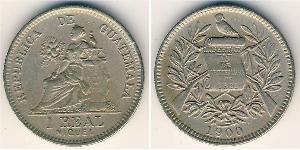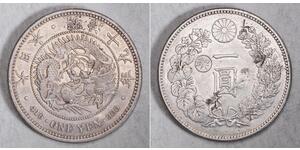(售价 $68.0)
1834, Spain, Écija. Large Copper "Friends of the Country Economic Society" Proclamation Medal
Mint Year: 1834 Reference: Herrera 10, V.Q. 13360. Condition: Edge-hits and light scratches, minor deposits, otherwise about XF! Denomination: Proclamation Medal of the town of Écija (Seville provinc, spain) - Issued by the Economic Society of Friends of the Country in 1834. Material: Copper Weight: 22.94gm Diameter: 38mm
Obverse: Large sun with human face, surrounded by inscription. Legend: ** EN LA PROCLAMAC . AUGUS . DE ISABEL
Reverse: Name of the tow (ECIJA) and date (1834) within wreathl. Legend: LA SOCIEDAD DE AMIGOS DEL PAIS / AH
The Sociedades Económicas de Amigos del País (Economic Societies of Friends of the Country) were private associations established in various cities throughout Enlightenment Spain, and to a lesser degree in some of Spain's overseas territories including (the Philippines, Puerto Rico, Cuba, Guatemala, Chile, Venezuela, Mexico, and elsewhere). The Sociedades Económicas were founded as part of a movement to stimulate the economic and intellectual development of Spain. Many Spaniards recognized that Spain was lagging behind other European states and sought to diffuse and apply the principles of the Enlightenment. A principal promoter of the Societies' foundation was Pedro Rodríguez de Campomanes, a highly influential statesman and one of the most important thinkers in contemporary Spain. Campomanes, on a more practical level, saw that the Societies could stimulate improvements in agriculture, husbandry, industry, the professions and arts. The first one, the Basque Society of Friends of the Country, was founded in 1765 by the Marquis de Peñaflorida, Xavier María de Munibe e Idiáquez. According to Popescu, within a few years, the number of Economic Societies in Spain had passed 50, and they were present in all major population centers. In Spain the organizations are credited with some success in sponsoring economic activity, stimulating new industries, and publicizing recent advances in philosophy and science (most of which emanated from England, France and Germany). These organizations were autonomous, although required to be licensed by royal authority, and their fortunes depended on a combination of the dedication of local members, official patronage, and the receptivity of the local community.
Écija is a town belonging to the province of Seville, Spain. It is in the Andalusian countryside, 85 km east of the city of Seville. According to the 2008 census, Écija has a total population of 40,100 inhabitants, ranking as the fifth most populous city in the province. The river Genil, the main tributary of the river Guadalquivir, runs through the urban area of the city. The economy of Écija is based on agriculture (olives, cereals and vegetables), cattle (cows and horses) and textile industry. The city has over twenty churches and convents, some of them with either Gothic, Mudéjar, Renaissance or Baroque towers or bell-gables, as well as an Arab fortress. In the Philippines, the province of Nueva Ecija that was created as a military comandancia in 1705 by Governor Fausto Cruzat y Góngora, was named in honor of this city.
Isabella II (Spanish: Isabel II; 10 October 1830 – 10 April 1904) was the only Queen regnant of Spain in modern times. She came to the throne as an infant, but her succession was disputed by the Carlists, who refused to recognise a female sovereign, leading to the Carlist Wars. After a troubled reign, she was deposed in the Glorious Revolution of 1868, and formally abdicated in 1870. Her son Alfonso XII became king in 1874.
Isabella was born in Madrid in 1830, the eldest daughter of King Ferdinand VII of Spain, and of his fourth wife and niece, Maria Christina, who was a Neapolitan Bourbon. Maria Christina became regent on 29 September 1833, when her three-year old daughter Isabella was proclaimed queen regnant on the death of the king.
Isabella succeeded to the throne because Ferdinand VII had induced the Cortes Generales to help him set aside the Salic law, introduced by the Bourbons in the early 18th century, and to re-establish the older succession law of Spain. The first pretender, Ferdinand's brother Carlos, fought seven years during the minority of Isabella to dispute her title. Carlos' and his descendants' supporters were known as Carlists, and the fight over the succession was the subject of a number of Carlist Wars in the 19th century.
Isabella's reign was maintained only through the support of the army. The Cortes and the Moderate Liberals and Progressives reestablished constitutional and parliamentary government, dissolved the religious orders and confiscated their property (including that of Jesuits), and tried to restore order to Spain's finances. After the Carlist war, the regent, Maria Christina, resigned to make way for Baldomero Espartero, Prince of Vergara, the most successful and most popular Isabelline general. Espartero, a Progressive, remained regent for only two years.
Baldomero Espartero was turned out in 1843 by a military and political pronunciamiento led by Generals Leopoldo O'Donnell and Ramón María Narváez. They formed a cabinet, presided over by Joaquin Maria Lopez. This government induced the Cortes to declare Isabella of age at 13.
Three years later, on 10 October 1846, the Moderate Party (or Castilian Conservatives) made their sixteen-year-old queen marry her double-first cousin Francisco de Asís de Borbón (1822–1902), the same day that her younger sister, Infanta Luisa Fernanda, married Antoine d'Orléans, Duke of Montpensier.
The marriages suited France and Louis Philippe, King of the French, who as a result nearly quarrelled with Britain. However, the marriages were not happy; persistent rumour had it that few if any of Isabella's children were fathered by her king-consort, rumoured to be a homosexual. The Carlist party asserted that the heir-apparent to the throne, who later became Alfonso XII, had been fathered by a captain of the guard, Enrique Puig y Moltó.
Isabella directly reigned from 1843 to 1868, a period of palace intrigues, back-stairs and antechamber influences, barracks conspiracies, and military pronunciamientos to further the ends of the political parties — Moderados who ruled from 1846 to 1854, Progressives from 1854 to 1856, and Unión Liberals from 1856 to 1863. Moderados and Unión Liberals quickly succeeded each other and kept out the Progressives, thus sowing the seeds for the Revolution of 1868.
Queen Isabella often interfered in politics in a wayward, unprincipled way that made her very unpopular. She showed favour to her reactionary generals and statesmen and to the Church and religious orders. Other events of her reign were the war against Morocco (1859), which ended in a treaty advantageous for Spain and cession of some Moroccan territory; the fruitless Chincha Islands War against Peru and Chile; tensions with the United States; independence revolts in Cuba and Puerto Rico; and some progress in public works, especially railways, and a slight improvement in commerce and finance.
At the end of September 1868, Isabella went into exile, after her Moderado generals had made a slight show of resistance that was crushed at the Battle of Alcolea by Generals Serrano and Prim. This revolt, which deposed Isabella, is known as the Glorious Revolution, and ushered the First Spanish Republic into power. The new government replaced Isabella with Amadeo I, second son of Victor Emmanuel II of Italy, after much deliberation.
Her exile helped cause the Franco-Prussian War, as Napoleon III could not accept the possibility that a German, Prince Leopold of Hohenzollern-Sigmaringen, might replace Isabella, a dynast of the Spanish Bourbons and great-great-granddaughter of the French-born Philip V of Spain.
The First Spanish Republic collapsed in December 1874. Isabella had been induced to abdicate in Paris on 25 June 1870, in favour of her son, Alfonso XII, furthering the cause of the Restoration. After the collapse of the Republic, Alfonso was placed on the throne.
She had left her husband the previous March and continued to live in France after the restoration in 1874, in a small circle with the Marqués de Alta Villa as her secretary. On the occasion of one of her visits to Madrid during Alfonso XII's reign, she began to intrigue with the politicians of the capital, and was peremptorily requested to go abroad again. She resided in Paris for the rest of her life, seldom traveling abroad except for a few visits to Spain. During her exile, she grew closer to her husband, with whom she maintained an ambiguous friendship until his death in 1902. Her last days were marked by the matrimonial problems of her youngest daughter, Eulalia. She died on 10 April 1904, and is entombed in El Escorial.
Only 1$ shipping for each additional item purchased!
1 Real 危地马拉 銀
本组有 3 钱币 / 1 售价
⇑
1 Yen 大日本帝国 (1868 - 1947) 銀 明治天皇 (1852 - 1912)
本组有 19 钱币 / 13 售价
⇑









-300-150-OtAKbzbigcQAAAFLmyKjltiV.jpg)






